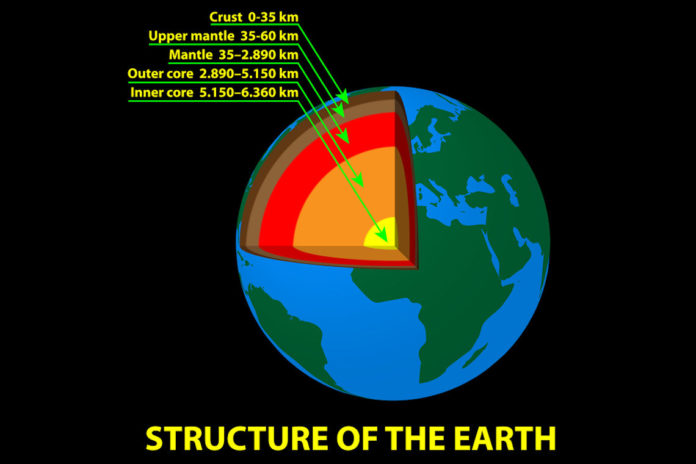The structure of the Earth consists of three main layers. The Earth is not a uniform solid. Instead, it is layered like an onion. Each layer has different and distinct properties.
The Layers of the Earth
The Crust
The structure of the Earth begins with the crust. The crust is the outer layer of the planet that we live on. The thickness of the crust ranges from 5 kilometers to 70 kilometers.
Ocean Basins: The thinnest part of the crust is found in the ocean basins. Although it is thin, it is also the most dense part of the earth’s crust.
Continental Crust: The thickest part of the earth’s crust is the continental crust. This part of the earth’s crust makes up the continents. However, it is made up of materials that are less dense than the oceanic crust.
The Mantle
The mantle is the layer just below the crust. It is about 3,000 kilometers thick and makes up 85% of the planet. The mantle has two layers. The upper mantle has a temperature of 900° Celsius. The lower mantle is much hotter with a temperature of 2,200° Celsius.
The Upper Mantle: The “lithosphere” is the solid part of the earth’s upper mantle combined with the earth’s crust. The upper mantle is found 50 to 700 kilometers below the earth’s surface.
On the other hand, the “asthenosphere” is the liquid part of the upper mantle. Large pieces of the solid lithosphere floats on the liquid aesthenosphere. As the asthenosphere circulates, it actually causes the lithosphere to move. This movement helps create landforms such as mountain systems and oceanic trenches.
The Lower Mantle: The lower mantle is about 700 to 3,000 kilometers below the earth’s surface. The lower mantle is thought to be made up of partially melted rock.
The Earth’s Core
The Outer Core: The earth’s core is also made up of two layers. The outer core is about 3,000 kilometers below the earth’s surface. It is about 2,300 kilometers thick. It is made up mostly of nickel and iron. Temperatures are so hot that the outer core is molten liquid metal.
The Inner Core: The deepest layer of the earth’s structure is the inner core. It is about 1,300 kilometers thick. Temperatures and pressures are so high that the liquid material of the core begins to behave like a solid. Temperatures are about 5,000° Celsius and pressures are more than a million times greater than at the earth’s surface.
Reflections
Vocabulary
- crust
- mantle
- core
Notes
- The earth is layered like an onion.
- A crust, mantle, and core are the three major layers in the structure of the Earth.
- Solid material of the crust floats on a liquid part of the mantle.

